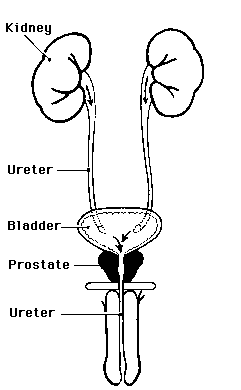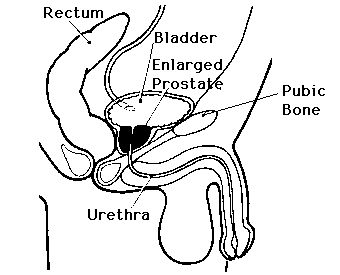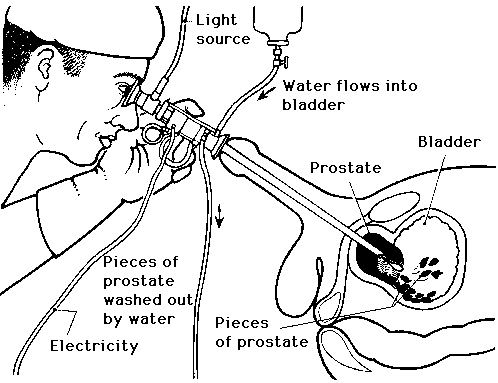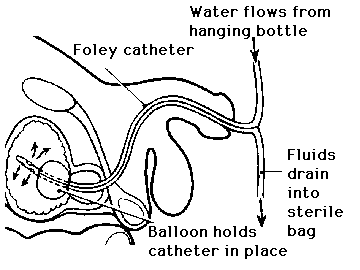
The prostate is a walnut-sized gland that forms part of the male reproductive system . The gland is made of two lobes, or regions, enclosed by an outer layer of tissue. As the diagrams show, the prostate is located in front of the rectum and just below the bladder, where urine is stored. The prostate also surrounds the urethra, the canal through which urine passes out of the body.
Scientists do not know all the prostate's functions. One of its main roles, though, is to squeeze fluid into the urethra as sperm move through during sexual climax. This fluid, which helps make up semen , energizes the sperm and makes the vaginal canal less acidic.
One of the gland's main roles is to squeeze fluid into the urethra as sperm move through during sexual climax.

The Male Urinary Tract.
It is common for the prostate gland to become enlarged as a man ages. Doctors call the condition benign prostatic hyperplasia (BPH), or benign prostatic hypertrophy.
As a male matures, the prostate goes through two main periods of growth. The first occurs early in puberty, when the prostate doubles in size. At around age 25, the gland begins to grow again. It is this second growth phase that often results, years later, in BPH.
Though the prostate continues to grow during most of a man's life, the enlargement doesn't usually cause problems until late in life. BPH rarely causes symptoms before age 40, but more than half of men in their sixties and as many as 90 percent in their seventies and eighties have some symptoms of BPH.
As the prostate enlarges, the surrounding capsule stops it from expanding, causing the gland to press against the urethra like a clamp on a garden hose. The bladder wall becomes thicker and irritable. The bladder begins to contract even when it contains small amounts of urine, causing more frequent urination . As the bladder weakens, it loses the ability to empty itself, and urine remains behind. This narrowing of the urethra and partial emptying of the bladder cause many of the problems associated with BPH.
Many people feel uncomfortable talking about the prostate, since the gland plays a role in both sex and urination. Still, prostate enlargement is as common a part of aging as gray hair. As life expectancy rises, so does the occurrence of BPH. In the United States alone, 350,000 operations take place each year for BPH.
It is not clear whether certain groups face a greater risk of getting BPH. Studies done over the years suggest that BPH occurs more often among married men than single men and is more common in the United States and Europe than in other parts of the world. However, these findings have been debated, and no definite information on risk factors exists.

Normal urine flow.

Urine Flow with BPH
The cause of BPH is not well understood. For centuries, it has been known that BPH occurs mainly in older men and that it doesn't develop in males whose testes were removed before puberty. For this reason, some researchers believe that factors related to aging and the testes may spur the development of BPH.
Throughout their lives, men produce both testosterone, an important male hormone , and small amounts of estrogen, a female hormone. As men age, the amount of active testosterone in the blood decreases, leaving a higher proportion of estrogen. Studies done with animals have suggested that BPH may occur because the higher amount of estrogen within the gland increases the activity of substances that promote cell growth.
Another theory focuses on dihydrotestosterone (DHT), a substance derived from testosterone in the prostate, which may help control its growth. Most animals lose their ability to produce DHT as they age. However, some research has indicated that even with a drop in the blood's testosterone level, older men continue to produce and accumulate high levels of DHT in the prostate. This accumulation of DHT may encourage the growth of cells. Scientists have also noted that men who do not produce DHT do not develop BPH.
Some researchers suggest that BPH may develop as a result of "instructions" given to cells early in life. According to this theory, BPH occurs because cells in one section of the gland follow these instructions and "reawaken" later in life. These "reawakened" cells then deliver signals to other cells in the gland, instructing them to grow or making them more sensitive to hormones that influence growth.
Many symptoms of BPH stem from obstruction of the urethra and gradual loss of bladder function, which results in incomplete emptying of the bladder. The symptoms of BPH vary, but the most common ones involve changes or problems with urination , such as:
The size of the prostate does not always determine how severe the obstruction or the symptoms will be. Some men with greatly enlarged glands have little obstruction and few symptoms while others, whose glands are less enlarged, have more blockage and greater problems.
Sometimes a man may not know he has any obstruction until he suddenly finds himself unable to urinate at all. This condition, called acute urinary retention, may be triggered by taking over-the-counter cold or allergy medicines. Such medicines contain a decongestant drug, known as a sympathomimetic, which may, as a side effect, prevent the bladder opening from relaxing and allowing urine to empty. When partial obstruction is present, urinary retention also can be brought on by alcohol, cold temperatures, or a long period of immobility.
It is important to tell your doctor about urinary problems such as those described above. In 8 out of 10 cases, these symptoms suggest BPH, but they also can signal other, more serious conditions that require prompt treatment. These conditions can be ruled out only by a doctor's exam.
Severe BPH can cause serious problems over time. Urine retention and strain on the bladder can lead to urinary tract infections, bladder or kidney damage, bladder stones, and incontinence . If the bladder is permanently damaged, treatment for BPH may be ineffective. When BPH is found in its earlier stages, there is a lower risk of developing such complications.
You may first notice symptoms of BPH yourself, or your doctor may find that your prostate is enlarged during a routine checkup. When BPH is suspected, you may be referred to a urologist, a doctor who specializes in problems of the urinary tract and the male reproductive system . Several tests help the doctor identify the problem and decide whether surgery is needed. The tests vary from patient to patient, but the following are the most common:
This exam is usually the first test done The doctor inserts a gloved finger into the rectum and feels the part of the prostate next to the rectum. This exam gives the doctor a general idea of the size and condition of the gland.
If there is a suspicion of prostate cancer, your doctor may recommend test with rectal ultrasound . In this procedure, a probe inserted in the rectum directs sound waves at the prostate. The echo patterns of the sound waves form an image of the prostate gland on a display screen.
Sometimes the doctor will ask a patient to urinate into a special device which measures how quickly the urine is flowing. A reduced flow often suggests BPH.
IVP is an x-ray of the urinary tract . In this test, a dye is injected into a vein, and the x-ray is taken. The dye makes the urine visible on the x-ray and shows any obstruction or blockage in the urinary tract.
In this exam, the doctor inserts a small tube through the opening of the urethra in the penis. This procedure is done after a solution numbs the inside of the penis so all sensation is lost.) The tube, called a cystoscope, contains a lens and a light system, which help the doctor see the inside of the urethra and the bladder. This test allows the doctor to determine the size of the gland and identify the location and degree of the obstruction.
Men who have BPH with symptoms usually need some kind of treatment at some time. However, a number of recent studies have questioned the need for early treatment when the gland is just mildly enlarged. These studies report that early treatment may not be needed because the symptoms of BPH clear up without treatment in as many as one-third of all mild cases. Instead of immediate treatment, they suggest regular checkups to watch for early problems. If the condition begins to pose a danger to the patient's health or causes a major inconvenience to him, treatment is usually recommended.
Since BPH may cause urinary tract infections, a doctor will usually clear up any infection with antibiotics before treating the BPH itself. Although the need for treatment is not usually urgent, doctors generally advise going ahead with treatment once the problems become bothersome or present a health risk. The following section describes the types of treatment that are most commonly used for BPH.
Most doctors recommend removal of the enlarged part of the prostate as the best long-range solution for patients with BPH. With surgery for BPH, only the enlarged tissue that is pressing against the urethra is removed; the rest of the inside tissue and the outside capsule are left intact. Surgery usually relieves the obstruction and incomplete emptying caused by BPH. The following section describes the types of surgery that are used.
Transurethral Surgery. In this type of surgery, no external incision is needed. After giving anesthesia , the surgeon reaches the prostate by inserting an instrument through the urethra.
A procedure called TURP (transurethral resection of the prostate) is used for 90 percent of all prostate surgeries done for BPH. With TURP, an instrument called a resectoscope is inserted through the penis. The resectoscope, which is about 12 inches long and 1/2 inch in diameter, contains a light, valves for controlling irrigating fluid, and an electrical loop that cuts tissue and seals blood vessels.

TURP is used for 90 percent of all surgeries done for BPH.
During the 90-minute operation, the surgeon uses the resectoscope's wire loop to remove the obstructing tissue one piece at a time. The pieces of tissue are carried by the fluid into the bladder and then flushed out at the end of the operation.
Although this procedure is delicate and requires a skilled surgeon, most doctors suggest using TURP whenever possible. Transurethral procedures are less traumatic than open forms of surgery and require a shorter recovery period.
Another surgical procedure is called transurethral incision of the prostate (TUIP). Instead of removing tissue, as with TURP, this procedure widens the urethra by making a few small cuts in the bladder neck, where the urethra joins the bladder, and in the prostate gland itself. Although some people believe that TUIP gives the same relief as TURP with less risk of side effects such as retrograde ejaculation , its advantages and long-term side effects have not been clearly established.
Open Surgery. In the few cases when a transurethral procedure cannot be used, open surgery, which requires an external incision, may be used. Open surgery is often done when the gland is greatly enlarged, when there are complicating factors, or when the bladder has been damaged and needs to be repaired. The location of the enlargement within the gland and the patient's general health help the surgeon decide which of the three open procedures to use.
With all the open procedures, anesthesia is given and an incision is made. Once the surgeon reaches the prostate capsule, he scoops out the enlarged tissue from inside the gland.
Some researchers are exploring the use of lasers to vaporize obstructing prostate tissue. Early studies suggest that this method may be as effective as conventional surgery.
Following surgery, you'll probably stay in the hospital from 3 to 10 days depending on the type of surgery you had and how quickly you recover.
At the end of surgery, a special catheter is inserted through the opening of the penis to drain urine from the bladder into a collection bag. Called a Foley catheter, this device has a water-filled balloon on the end that is placed in the bladder, which keeps it in place.
This catheter is usually left in place for several days. Sometimes, the catheter causes recurring painful bladder spasms the day after surgery. These may be difficult to control, but they will eventually disappear.

Foley Catheter
You may also be given antibiotics while you are in the hospital. Many doctors start giving this medicine before or soon after surgery to prevent infection. However, some recent studies suggest that antibiotics may not be needed in every case, and your doctor may prefer to wait until an infection is present to give them.
After surgery, you will probably notice some blood or clots in your urine as the wound starts to heal. If your bladder is being irrigated (flushed with water), you may notice that your urine becomes red once the irrigation is stopped. Some bleeding is normal, and it should clear up by the time you leave the hospital. During your recovery, it is important to drink a lot of water (up to 8 cups a day) to help flush out the bladder and speed healing.
Take it easy the first few weeks after you get home. You may not have any pain, but you still have an incision that is healing -- even with transurethral surgery, where the incision can't be seen. Since many people try to do too much at the beginning and then have a setback, it is a good idea to talk to your doctor before resuming your normal routine. During this initial period of recovery at home, avoid any straining or sudden movements that could tear the incision. Here are some guidelines:
Even though you should feel much better by the time you leave the hospital, it will probably take a couple of months for you to heal completely. During the recovery period, the following are some common problems that occur:
Problems Urinating. You may notice that your urinary stream is stronger right after surgery, but it may take awhile before you can urinate completely normally again. After the catheter is removed, urine will pass over the surgical wound on the prostate, and you may initially have some discomfort or feel a sense of urgency when you urinate. This problem will gradually lessen, though, and after a couple of months you should be able to urinate less frequently and more easily.
Inability to Control Urination (Incontinence).As the bladder returns to normal, you may have some temporary problems controlling urination , but long-term incontinence rarely occurs. Doctors find that the longer problems existed before surgery, the longer it will take for the bladder to regain its full function after the operation.
Bleeding. In the first few weeks after transurethral surgery, the scab inside the bladder may loosen, and blood may suddenly appear in the urine. Although this can be alarming, the bleeding usually stops with a short period of resting in bed and drinking fluids. However, if your urine is so red that it is difficult to see through or if it contains clots or if you feel any discomfort, be sure to contact your doctor.
Many men worry about whether surgery for BPH will affect their ability to enjoy sex. Some sources state that sexual function is rarely affected, while others claim that it can cause problems in up to 30 percent of all cases. However, most doctors say that even though it takes awhile for sexual function to return fully, with time, most men are able to enjoy sex again.
Complete recovery of sexual function may take up to 1 year, lagging behind a person's general recovery. The exact length of time depends on how long BPH surgery was postponed despite symptoms and on the type of surgery that was done. Here is a summary of how surgery is likely to affect the following aspects of sexual function.
Most doctors agree that if you were potent (able to maintain an erection) shortly before surgery, you will probably be able to have erections afterward. Surgery rarely causes a loss of potency. However, surgery cannot usually restore potency that was lost before the operation.
Although most men are able to continue having erections after surgery, a prostatectomy frequently makes them sterile (unable to father children) by causing a condition called "retrograde ejaculation" or "dry climax."
During sexual activity, sperm from the testicles enters the urethra near the opening of the bladder. Normally, a muscle blocks off the entrance to the bladder, and the semen is expelled through the penis. However, the coring action of prostate surgery cuts this muscle as it widens the neck of the bladder. Following surgery, the semen takes the path of least resistance and enters the wider opening to the bladder rather than being expelled through the penis. Later it is harmlessly flushed out with urine.
Most men find little or no difference in the sensation of orgasm, or sexual climax, before and after surgery. Although it may take some time to get used to retrograde ejaculation, you should eventually find sex as pleasurable after surgery as before.
Many people have found that concerns about sexual function can interfere with sex as much as the operation itself. Understanding the surgical procedure and talking over any worries with the doctor before surgery often help men regain sexual function earlier. Many men also find it helpful to talk to a counselor during the adjustment period after surgery.
In the years after your surgery, it is important to continue having a rectal exam once a year and to have any symptoms checked by your doctor.
Since surgery for BPH leaves behind a good part of the gland, it is still possible for prostate problems, including BPH, to develop again. However, surgery usually offers relief from BPH for at least 15 years. Only 10 percent of the men who have surgery for BPH eventually need a second operation for enlargement. Usually these are men who had the first surgery at an early age.
Sometimes, scar tissue resulting from surgery requires treatment in the year after surgery. Rarely, the opening of the bladder becomes scarred and shrinks, causing obstruction. This problem may require a surgical procedure similar to transurethral incision (see section on surgery). More often, scar tissue may form in the urethra and cause narrowing. This problem can usually be solved during an office visit when the doctor stretches the urethra.
Balloon Urethroplasty. In this procedure, a thin tube with a balloon is inserted into the opening of the penis and guided to the narrowed portion of the urethra, where the balloon in inflated. This action widens the urethra, easing the flow of urine.
Balloon urethroplasty. is a simple procedure that can be done on an outpatient basis, so it may eventually offer men a safe alternative to surgery. Since the procedure doesn't actually remove the tissue causing the obstruction, more studies are needed to judge its long-range effectiveness.
Transurethral Hyperthermia. Researchers are also investigating a procedure that uses heat to shrink the prostate. During a series of treatments spread over several weeks, a doctor inserts a catheter containing a heating antenna into the urethra and then applies concentrated heat to the enlarged tissue, gradually shrinking it and relieving the obstruction. However, the long-range effectiveness of hyperthermia is not clear, and studies have indicated that the frequent insertion of a catheter and the use of heat can cause side effects such as irritation of the urethra, bleeding, or painful bladder spasms.
Prostatic Stents. Doctors in Europe are studying the use of devices, or stents, which are inserted through the urethra to the narrowed area and allowed to expand, like a spring. The stent pushes back the prostatic tissue, widening the urethra.
Medical Treatment. Over the years, researchers have tried to find a way to shrink or at least stop the growth of the prostate without using surgery. Recently, scientists have developed several new medications that are now being tested in clinical trials to determine whether they are safe and effective.
The Food and Drug Administration (FDA) has approved two drugs to treat BPH. Finasteride (marketed under the name Proscar), FDA approved in June 1992, inhibits production of the hormone that is involved with prostate enlargement. Its use can actually shrink the prostate in some men.
In September 1993, FDA also approved the drug terazosin (marketed under the name Hytrin) to treat BPH. Terazosin acts by relaxing the smooth muscle of the prostate and bladder neck to improve urine flow and to reduce bladder outlet obstruction. Terazosin, which belongs to the class of drugs known as alpha blockers, has been used as a treatment for hypertension since 1987.
Because drug treatment is not effective in all cases, surgery remains a common form of treatment for benign enlargement of the prostate.
Although some of the signs of BPH and prostate cancer are the same, having BPH does not seem to increase the chances of getting prostate cancer. Nevertheless, a man who has BPH may have undetected prostate cancer at the same time or may develop prostate cancer in the future. For this reason, the National Cancer Institute and the American Cancer Society recommend that all men over 40 have a rectal exam once a year to screen for prostate cancer.
After BPH surgery, the tissue removed is routinely checked for hidden cancer cells. In about 1 out of 10 cases, some cancer tissue is found, but often it is limited to a few cells of a nonaggressive type of cancer, and no treatment is needed.
NIH Pub. No. 91-3012, Revised September 1991